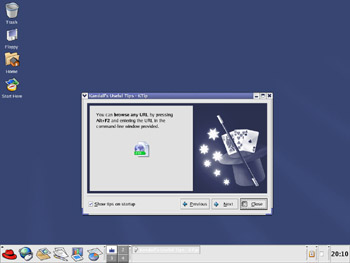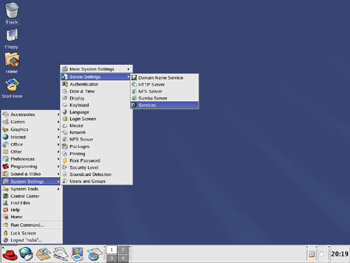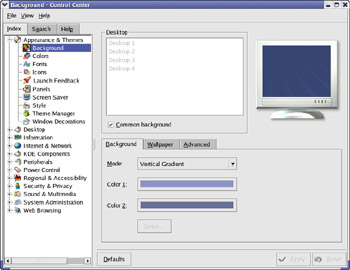Using KDE
Using KDE
KDE stands for the K Desktop Environment. The KDE project started in October 1996, with an intention to develop a common GUI for UNIX systems that use the X Window System. The first beta version of KDE was released a year later in October 1997, and KDE Version 1.0 was released in July 1998. KDE 2.0 was released on October 23, 2000. KDE 3.0 was released on April 3, 2002, and KDE 3.1 was released on January 28, 2003. Red Hat Linux comes with KDE 3.1.
From the user’s perspective, KDE provides a graphical desktop environment that includes a window manager, the Konqueror Web browser and file manager, a panel for starting applications, a help system, configuration tools, and many applications, including the KOffice office suite, image viewer, PostScript viewer, and mail and news programs.
From the developer’s perspective, KDE has class libraries and object models for easy appli-cation development in C++. KDE is a large development project with many collaborators.
The following sections provide an overview of KDE, but the best way to learn about KDE is to use it for a while. Follow the instructions in the section “Switching from GNOME to KDE” to change your GUI to KDE, then use it for a while to get a feel for KDE’s capabilities.
You can always find out the latest information about KDE by visiting the KDE home page at http://www.kde.org.
Taking Stock of KDE
Like GNOME, KDE is meant to be a complete desktop environment for users and a programming environment for application developers. Here are some key features of KDE:
-
KDE runs on a number of UNIX-like systems, including Linux, FreeBSD, Solaris, HP-UX, and Silicon Graphics IRIX. KDE needs the X Window System.
-
The latest KDE release is 3.1, also known as KDE 3.1 for short.
-
KDE is written in C++ and uses object-oriented development.
-
KDE uses the Qt Free Edition GUI toolkit from a Norwegian company, Trolltech AS (http://www.troll.no/). Qt is a C++ class library for building GUIs; it provides the widgets such as menus, buttons, and sliders used in KDE applications. There has been some controversy over the Qt license because its terms are not the same as the GNU General Public License. However, in September 2000, Trolltech announced that it would license Qt Free Edition, Version 2.2, under the GNU General Public License.
-
KDE provides an application development framework built on DCOP (Desktop Communications Protocol) and KParts, a compound document model. DCOP and KParts are similar to Microsoft’s DCOM (Distributed Component Object Model) and ActiveX controls.
-
KDE includes an office application suite based on the DCOP/KParts technology. The office suite, KOffice, includes a spreadsheet (KSpread), a charting program (KChart), a FrameMaker-like word processor (KWord), a presentation application (KPresenter), and a vector drawing program (Kontour).
-
KDE supports drag-and-drop operations.
-
KDE supports internationalization, and most KDE applications have been translated into over 25 different languages.
Exploring KDE
Assuming that you have selected KDE as your desktop (or selected a KDE session from the Session pop-up menu), you should get the KDE desktop when you log in. Figure 9-7 shows the default KDE desktop after I log in on my Red Hat Linux system.

Figure 9-7: The Initial KDE Desktop.
The initial desktop looks very similar to the GNOME desktop because Red Hat has configured both desktops and menus to look similar—so as to provide a consistent look and feel no matter which desktop users select. The initial KDE session includes a window showing a helpful tip. That’s the only part that makes the desktop look different from that in GNOME.
KDE is easy to use and has many similarities with the Microsoft Windows GUI. You can start applications from a menu that’s similar to the Start menu in Windows. KDE also enables you to place folders and applications directly on the desktop.
As Figure 9-7 shows, KDE provides a Windows-like desktop with a panel along the bottom edge of the screen. The most important component of the panel is the red hat button on the left-hand side. That button is like the Start button in Windows. When you click the red hat button, a pop-up menu appears. From this menu, you can get to other menus by moving the mouse over items with a right-pointing arrow. For example, Figure 9-8 shows a typical menu hierarchy for changing some desktop settings.

Figure 9-8: Viewing the Main Menu in KDE.
You can start applications from the main menu. That’s why the KDE documentation calls this button the Application Starter. Just to keep everything simple, I will refer to the red hat button as Main Menu.
| Insider Insight |
Red Hat has changed the Main Menu button to show a red hat icon (the Red Hat logo). In a normal KDE installation, the leftmost button is a large letter K on top of a gear. It’s sometimes called the K button for short. |
Next to the red hat button (Main Menu), the panel includes several other buttons. If you don’t know what a button does, simply move the mouse over the button, and a small pop-up window displays a brief message about that button.
KDE supports a virtual desktop. By default, you get four virtual desktops. You can click one of the buttons on the panel (see Figure 9-8) labeled 1, 2, 3, and 4 to switch to a specific desktop. Use the desktops to organize your application windows. You needn’t clutter up a single desktop with many open windows. When a desktop gets crowded, simply switch to another desktop and open the applications there.
Sometimes you want to type Linux commands at a text prompt. Select Main Menu>System Tools>Terminal and a terminal window appears. You can then type Linux commands at the shell prompt in the terminal emulation window. Chapter 7 describes the shell and some important Linux commands.
To log out of KDE, select Main Menu>Logout, and click the Logout button on the resulting dialog box.








